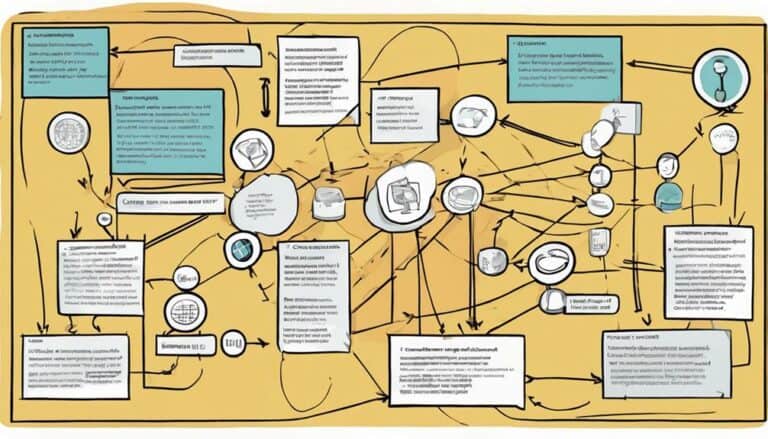When faced with complex decisions, you might wonder about the essential elements needed for a robust decision-making framework. Understanding the key components can be vital in sailing the intricate process of making informed choices.
By exploring the foundations that underpin effective decision-making frameworks, you will gain insights into structuring your decision-making processes with clarity and precision, ultimately leading to more successful outcomes.
Key Takeaways
- Define the problem to identify root causes and scope.
- Generate and evaluate alternatives using diverse perspectives.
- Choose the best alternative based on feasibility and alignment.
- Implement decisions with clear plans and monitor for refinement.
Defining the Problem
When defining the problem within a decision-making framework, it's imperative to meticulously identify the root causes, scope, impact, urgency, stakeholders, criteria, and constraints.
This foundational step lays the groundwork for effective decision-making by ensuring a clear understanding of the issue at hand. By pinpointing the root causes, you can address the source of the problem rather than just its symptoms. Understanding the scope helps in defining the boundaries within which potential solutions must lie.
Evaluating the impact allows you to grasp the consequences of different courses of action, aiding in making informed decisions. Moreover, recognizing the urgency of the problem enables you to prioritize tasks accordingly. Identifying stakeholders makes sure that all relevant parties are considered in the decision-making process.
Establishing criteria and constraints provides a framework for evaluating and selecting the most suitable solution. Finally, gathering necessary data is critical for making well-informed decisions based on facts rather than assumptions.
Generating Alternatives
To enhance the decision-making process, it's essential to employ techniques such as brainstorming, mind mapping, and SWOT analysis for generating a diverse range of alternatives. Here are three key points to contemplate for effectively generating alternatives:
- Team Involvement: Encourage active participation from team members to gather a wide array of perspectives and ideas. Collaborating with individuals from different backgrounds can lead to innovative and well-rounded alternative solutions.
- Expert Insights: Seek input from subject matter experts to gain valuable insights into the feasibility, benefits, costs, and risks associated with each alternative. Their expertise can provide a deeper understanding of the potential implications of the alternatives under consideration.
- Scenario Planning: Utilize tools like SWOT analysis and scenario planning to systematically evaluate and compare different alternative options. This structured approach aids in evaluating the viability of each alternative while contemplating its potential impact on the decision-making process.
Evaluating Alternatives
As you move towards evaluating alternatives, your focus shifts to examining the feasibility, benefits, costs, risks, and implications of each option. Utilizing tools like decision matrices, pros and cons lists, and cost-benefit analysis aids in ranking and prioritizing alternatives effectively.
Seeking input from your team and stakeholders is essential to gather diverse perspectives and guarantee a thorough evaluation process.
During evaluation, it's critical to assess the potential impact of each alternative while also conducting a thorough risks assessment to minimize unexpected outcomes. Prioritizing alternatives based on their alignment with goals, values, and desired outcomes is key in making informed decisions.
Effective evaluation involves considering not just the immediate benefits but also the long-term consequences of each option.
Choosing the Best Alternative
Consider the key factors such as feasibility, benefits, costs, risks, and implications when deciding on the best alternative in your decision-making process. To effectively choose the best alternative, follow these steps:
- Utilize Decision Matrix or Pros and Cons List: Create a decision matrix or list out the pros and cons of each alternative to visually compare and contrast their attributes.
- Conduct Cost-Benefit Analysis: Perform a cost-benefit analysis for each alternative to determine the financial impact and benefits associated with each option.
- Engage Stakeholders for Input: Gather input from your team and relevant stakeholders to gain diverse perspectives and insights, ensuring that all viewpoints are considered in the decision-making process.
Implementing and Reviewing the Decision
When implementing a decision, ensuring alignment with goals and values is essential for successful execution and desired outcomes. Begin by executing the decision according to a well-defined plan that includes clear communication and a robust monitoring process. It's important to communicate the decision to all stakeholders to guarantee understanding and successful execution. Continuous monitoring of the implementation process allows for refinement, leading to improved decision-making outcomes.
Reviewing the decision against expected outcomes is a vital step in the decision-making framework. Seeking feedback from stakeholders and adjusting future decisions based on lessons learned enhances the decision-making process. By incorporating feedback and adjusting where necessary, you can guarantee that future decisions are more informed and aligned with organizational goals and values.
Conclusion
When steering through complex decision-making processes, having a structured framework is like having a compass in a stormy sea.
By defining the problem, generating alternatives, evaluating options, choosing the best course of action, and implementing and reviewing decisions, you can steer your ship towards success.
So, remember, a decision-making framework is your guiding star in the turbulent waters of choice.

